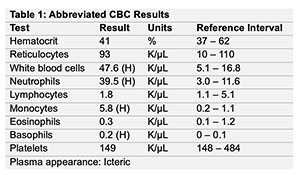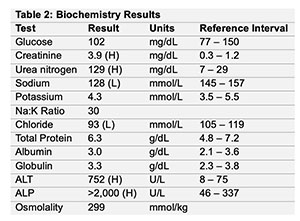Clinical pathologic results from a puppy
Case Information
A 15-week-old female Maltese puppy weighing 1.5 kg was presented to the primary care veterinarian with a one day history of lethargy and vomiting. The puppy was purchased from a breeder 6 weeks prior and had received vaccinations for Bordetella vaccine and distemper, adenovirus, parainfluenza, parvovirus (DAPP x 2). She did not interact with other animals or walk on the street, but did have access to a private outdoor backyard behind the owner’s apartment where she was let out daily. There was no known history of dietary indiscretion or foreign material ingestion. The owner declined diagnostic testing at the initial visit and the puppy was given an anti-emetic injection and one dose of an oral dewormer. The puppy’s vomiting and lethargy persisted and she was presented to the Emergency Service the next day for evaluation. On physical examination, she had a dull demeanor, dry/tacky mucous membranes, and mildly icteric skin. Other than the treatments given the day prior by her primary care veterinarian, the puppy was not on any medications. A point-of-care Parvovirus Fecal Antigen ELISA snap test was negative. Abdominal radiographs were unremarkable.
This patient’s complete blood count (CBC, with a point-of-care Procyte analyzer) and biochemistry results (Tables 1 and 2) and the white blood cell (WBC) dot plot from the analyzer (Figure 1) are shown below. Evaluate these results in conjunction with the history and answer the following questions:
- Interpret the leukogram. With no blood smear available to review, what do you think about the accuracy of the CBC differential count when looking at the WBC dot plot?
- What is your top differential diagnosis?
- What are potential findings in a urinalysis from this patient as a result of your top differential diagnosis?
 |
 |
Answers on next page

